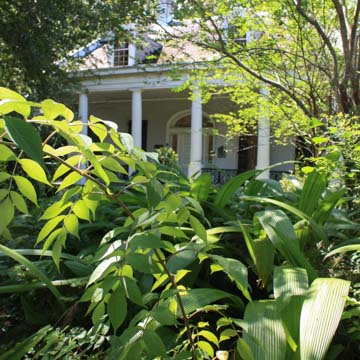Located on the old road to Bayou St. John and the site of the first brickyard in New Orleans, this raised house of stuccoed brick with a six-columned wooden gallery was built for the keeper of the city jail, Simon Meilleur, and his Philadelphia-born wife, Catherine Flack. A 1990s restoration preserved the original central-hall layout and exterior appearance, reconstructed the slate roof and the two roof dormers destroyed in a fire in 1911, and re-created the decorative cast-iron gallery railing. A central entrance door is framed by delicate Ionic columns, sidelights, and a fanlight. The house is surrounded by a garden of dubious historical authenticity. Numerous adjacent structures are now included in the museum’s campus, including the Passebon Cottage (1843), built by free man of color and builder, Pierre Passebon, and restored post–Hurricane Katrina under the direction of Pierre-Antoine Gatier, Chief Architect of Historical Monuments, French Ministry of Culture, with funding from the Government of France.
You are here
New Orleans African American Museum of Art, Culture and History (Villa Meilleur)
1828–1829, attributed to William Brand or Joseph Correjoles; 1990s restored, Williams and Associates, with Eugene D. Cizek. 1418 Governor Nicholls St.
If SAH Archipedia has been useful to you, please consider supporting it.
SAH Archipedia tells the story of the United States through its buildings, landscapes, and cities. This freely available resource empowers the public with authoritative knowledge that deepens their understanding and appreciation of the built environment. But the Society of Architectural Historians, which created SAH Archipedia with University of Virginia Press, needs your support to maintain the high-caliber research, writing, photography, cartography, editing, design, and programming that make SAH Archipedia a trusted online resource available to all who value the history of place, heritage tourism, and learning.















